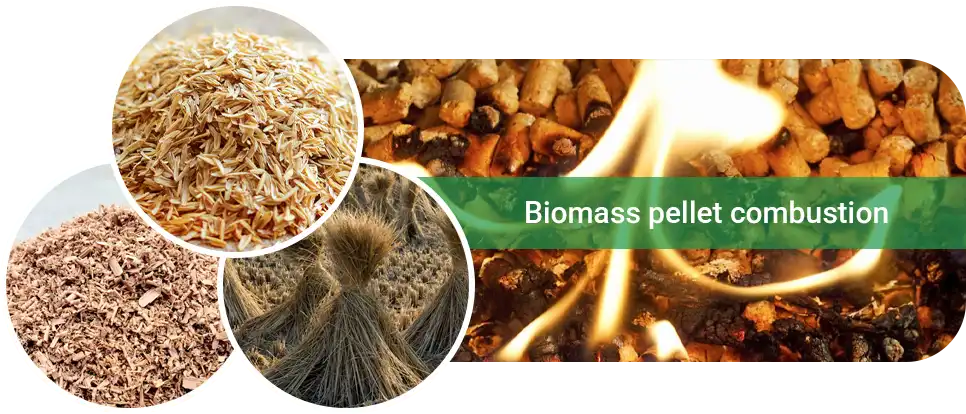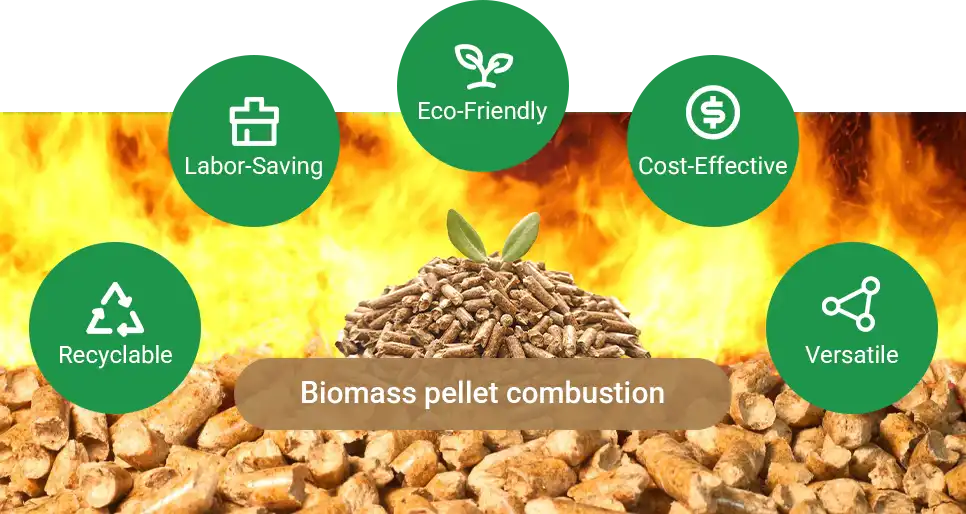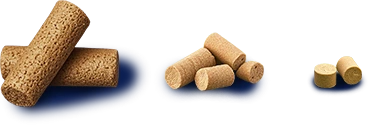Biomass pellet fuel is an eco-friendly energy source. It's made from agricultural and forestry waste like sawdust, straw, and rice husks. Pellet machines process this waste into pellets.
We’ll explore the calorific value, benefits, and future of biomass pellet fuel.

Composition of Different Biomass Materials
The calorific value of biomass pellet fuel primarily depends on its raw material composition. The table below shows the composition ratios of common biomass raw materials.
| Material | Moisture (Mad%) | Ash (Aar%) | Volatile Matter (Vdar%) | Fixed Carbon (FC%) | Lower Heating Value (kcal/kg) | Density (kg/m³) | Total Sulfur (Sar%) |
| Weeds | 5.43 | 9.1 | 68.27 | 16.4 | 3873 | - | 0.22 |
| Rice Straw | 3.61 | 12.2 | 67.8 | 19.36 | 4215 | - | 0.09 |
| Rice Husk | 5.62 | 17.82 | 62.61 | 13.95 | 3828 | - | 0.04 |
| Corn Stalk | 6.1 | 4.7 | 76 | 13.2 | 4241 | - | 0.11 |
| Corn Cob | 4.87 | 5.93 | 71.95 | 17.25 | 4238 | - | 0.01 |
| Wheat Straw | 4.39 | 8.9 | 67.36 | 19.32 | 4429 | - | 0.07 |
| Peanut Shell | 7.88 | 1.6 | 68.1 | 22.42 | 5119 | - | 0.1 |
| Fir Wood | 3.27 | 0.71 | 81.2 | 14.79 | 4587 | - | 0.03 |
| Pine Wood | 6 | 0.4 | 79.6 | 17 | 4552 | - | 0 |
| Poplar Wood | 6.7 | 1.5 | 80.3 | 11.5 | 4286 | - | 0.02 |
| Cow Dung | 6.46 | 32.4 | 48.72 | 12.52 | 2779 | - | 0.22 |
| Bituminous Coal | 8.85 | 21.37 | 38.48 | 31.3 | 5808 | - | 0.46 |
| Firewood | - | - | - | - | 4003 | - | - |
| Leaves | - | - | - | - | 3502 | - | - |
| Soybean Stalk | 5.1 | 3.13 | 74.56 | 17.12 | 3862 | - | 0.11 |
| Sorghum Stalk | 4.71 | 8.91 | 68.9 | 17.48 | 3601 | - | 0.01 |
| Cotton Stalk | 6.78 | 3.97 | 68.54 | 20.71 | 4323 | - | 0.22 |
| Wood Chips | 10 | 0.3 | 73 | 17.01 | 4401 | 0.5 | - |
Definitions:
Ash Content: The residual non-combustible material left after full combustion.
Volatile Matter: The combustible gases released when the material is heated.
Fixed Carbon: The remaining solid fuel after moisture, ash, and volatile matter are removed.
Lower Heating Value (LHV): The actual usable heat released during combustion.

Calorific Value of Different Biomass Pellets
The table below provides the energy values and applications of various biomass pellet fuels.
| Common Type | Raw Material | LHV (kcal/kg) | Density (t/m³) | Ash Content (%) | Applications |
| Pine Wood | Cedar, Spruce, Fir | 4300-4500 | ≥1.20 | ≤0.9 | Home heating, industrial boilers, biomass power generation |
| Hardwood | Oak, Catalpa, Elm | 4500 | ≥1.2 | ≤0.9 | High-efficiency heating, industrial boilers, power plants |
| Softwood | Poplar, Birch | 4300 | ≥1.20 | ≤1.1 | Home heating, biomass boilers, industrial heating |
| Agricultural Waste | Soybean Stalk, Cotton Stalk, Peanut Shell | 3800 | ≥1.15 | ≤6.0 | Heating in rural areas, small-scale power generation, soil improvement |
| Corn Stalk, Rapeseed Stalk | 3700 | ≥1.15 | ≤6.0 | Biomass power generation, agricultural heating, animal feed | |
| Wheat Straw | 3500 | ≥1.10 | ≤7.0 | Heating in rural areas, small-scale power generation, organic fertilizer | |
| Potato Stalk | 3400 | ≥1.10 | ≤7.0 | Heating for livestock (pigsties, cow sheds), small boilers | |
| Rice Straw | 3200 | ≥1.10 | ≤8.0 | Heating in rural areas, small-scale power generation, composting |
(Note: The actual energy value of biomass pellets can vary based on raw material sources and processing techniques.)

Understanding Biomass Pellet Fuel Calorific Value
The calorific value of biomass pellet fuel refers to the energy released per unit mass during complete combustion. It is a critical indicator of fuel performance and economic viability.
Factors Affecting Calorific Value
- Raw Material Characteristics: The Key Factor Behind Calorific Value
The chemical and biological makeup of biomass largely determines its heat output. Different types of biomass burn differently because they contain varying amounts of lignin, cellulose, fats, and other components.
For example, pine wood, rich in lignin, produces more heat than cellulose-heavy straw. Even within the same plant, heat value varies by part. Tree trunks burn hotter due to higher lignin content, while leaves, with more moisture and less lignin, produce less heat.
- Physical Properties: The Key to Combustion Efficiency
Physical properties refer to the outward characteristics of biomass pellets, mainly moisture content, ash content, density, and volatile matter. These factors don’t directly affect calorific value but do impact combustion efficiency and energy density.
For example, dry wood has low moisture and ash. It’s denser and burns more efficiently, giving more energy per unit volume. Wet wood has higher moisture and ash, lower density, and burns less efficiently, producing less energy.
- Processing Techniques: Practical Methods to Improve Calorific Value
Processing plays a key role in enhancing the heat value and combustion efficiency of biomass pellets. Common techniques include drying, crushing and compressing, pyrolysis and gasification, and adding additives.
Drying reduces moisture content, which raises the calorific value. Crushing and compressing improve combustion efficiency and energy density. Pyrolysis and gasification convert biomass into higher-energy fuels. Adding suitable additives can further increase heat output or energy utilization.
- Common Question: Does pellet density affect calorific value?
The answer is no. Calorific value refers to energy per kilogram, while density indicates compactness. Higher density pellets provide more energy per unit volume.
For example, 1 kg of high-density pellets and 1 kg of low-density pellets release the same calorific value. However, high-density pellets are more compact, so they provide more energy per unit volume and are easier to store, transport, and burn.

Core Advantages of Biomass Pellet Fuel
- Recyclable: Ash from biomass pellets is a high-quality organic potassium fertilizer.
- Labor-Saving: Clean and easy to handle, reducing labor costs and improving working conditions.
- Eco-Friendly: Low sulfur, low ash, and minimal harmful emissions compared to coal.
- Cost-Effective: More stable pricing than coal or natural gas.
- Versatile: Suitable for home heating, industrial boilers, biomass power generation, and organic fertilizer production.
Future Prospects of Biomass Pellet Fuel
Biomass pellet fuel is eco-friendly, efficient, and renewable. It is widely used for home heating, industrial boilers, power generation, and clean energy in rural areas. In the future, optimized technology and policy incentives will expand the role of biomass energy in the global green energy transition.




